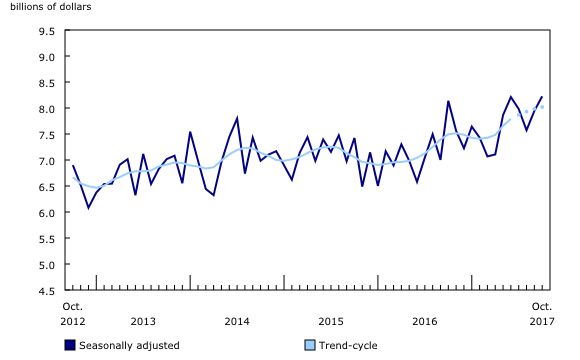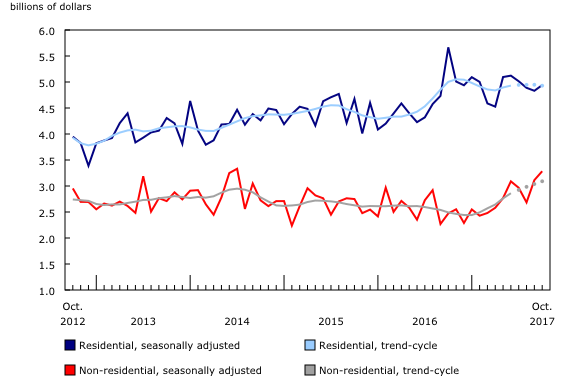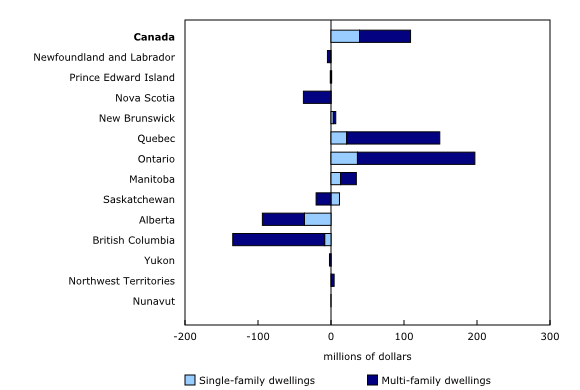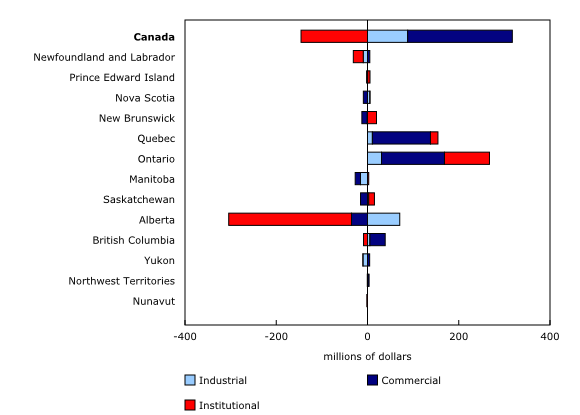Building permits, October 2017
Archived Content
Information identified as archived is provided for reference, research or recordkeeping purposes. It is not subject to the Government of Canada Web Standards and has not been altered or updated since it was archived. Please "contact us" to request a format other than those available.
Released: 2017-12-07
$8.2 billion
October 2017
3.5% 
(monthly change)
$54.4 million
October 2017
-36.3% 
(monthly change)
$25.8 million
October 2017
15.0% 
(monthly change)
$101.1 million
October 2017
-29.1% 
(monthly change)
$109.9 million
October 2017
14.6% 
(monthly change)
$1,721.7 million
October 2017
21.4% 
(monthly change)
$3,507.7 million
October 2017
15.3% 
(monthly change)
$218.0 million
October 2017
5.0% 
(monthly change)
$145.5 million
October 2017
-5.8% 
(monthly change)
$992.1 million
October 2017
-24.8% 
(monthly change)
$1,328.7 million
October 2017
-7.3% 
(monthly change)
$9.7 million
October 2017
-43.2% 
(monthly change)
$9.7 million
October 2017
294.9% 
(monthly change)
$0.4 million
October 2017
-76.2% 
(monthly change)
The value of building permits rose for a second straight month, up 3.5% to $8.2 billion in October. All building components increased with the exception of the institutional component, which declined 14.3%, offsetting much of the gain from the previous month.
Commercial and industrial components push the non-residential sector higher
The value of permits for non-residential buildings increased $171.7 million to $3.3 billion in October, the second consecutive monthly gain.
The commercial component, which refers to buildings used in the trade or distribution of goods and services, was the main contributor to the 5.5% increase in the non-residential sector. Permits in Quebec for warehouses, as well as permits in Ontario for office buildings, warehouses, and recreation buildings, contributed to the rise in the value of commercial building permits in October.
Nationally, the value of permits for the industrial component passed the $700 million-mark for the first time in five years. The gain stemmed primarily from higher construction intentions for factories and plants in Alberta. Nationally, the year-to-date value of permits for the industrial component totalled $5.3 billion, $1.0 billion higher than the same period in 2016.
Ontario and Quebec up in all building components
The value of building permits was up for all components in Ontario and Quebec in October.
Ontario municipalities issued $3.5 billion in building permits in October, up 15.3% from the previous month. Just over one-third of the monthly increase stemmed from the higher value of multi-family dwelling permits (+23.1%), which saw its first rise following three consecutive monthly declines.
Ontario's construction intentions for single-family dwellings also rose in October, up 3.3% from September. Despite this increase in the value of permits, the number of single-family dwelling units approved for construction fell 0.4%.
In Ontario's non-residential sector, the value of permits increased 21.2% to $1.5 billion. The commercial component reached $733.5 million, the highest level since September 2014, while the industrial sector rose to $373.4 million, the highest value since May 2010.
Quebec municipalities issued $1.7 billion worth of building permits in October, up 21.4% from the previous month. The value of permits for multi-family dwellings led the residential increase (+$127.5 million), while the commercial component (+$127.3 million) pushed the non-residential sector higher.
In Quebec, the value of multi-family dwelling permits was $686.6 million in October, with 78.4% of the value coming from the census metropolitan area (CMA) of Montréal. The value of permits for multi-family dwellings has increased every month since February. This eight-month streak is the longest on record for the province. Multiple high-value permits for apartment condominiums in the Montréal CMA were mainly responsible for the provincial increase in October.
Construction intentions for multi-family dwellings in Montréal continue to climb
In October, the value of permits for both single-family and multi-family dwellings increased in the CMAs of Montréal and Toronto. However, in the Vancouver CMA, both residential components fell, offsetting the gains in September.
Municipalities in the CMA of Montréal issued $538.1 million in permits for multi-family dwellings in October, higher than in Toronto ($409.2 million) and Vancouver ($330.6 million). In regards to single-family homes, Toronto registered $451.3 million in permits, followed by Vancouver ($148.1 million) and Montréal ($122.4 million).
The Montréal CMA issued permits approving the construction of 2,956 new units, stemming mainly from multi-family dwellings (2,720). October marked the fifth consecutive month where the number of units approved for multi-family dwellings exceeded 2,000. Vancouver approved the construction of 1,860 new units for multi-family homes, while Toronto (1,691) approved fewer despite having a higher value for the component.

In celebration of the country's 150th birthday, Statistics Canada is presenting snapshots from our rich statistical history.
"Owing to the increasing use of the automobile and other means of rapid transportation, a growing percentage of those who work in the cities reside outside the municipal boundaries. Hence arises in part the necessity for the extension of the record of building permits to include such suburban areas as the York Townships in the case of Toronto, and North and South Vancouver." (The Canada Year Book: 1926 pg. 432)
As noted in the 1926 Canada Year Book, the need to capture building permit data for municipalities just outside the City of Toronto and the City of Vancouver was identified almost a century ago. As there is limited land for new development, data for these cities versus their census metropolitan areas (CMAs) paint a very different picture of their construction intentions over the years. Reasonably priced single-detached homes outside the city can be built to supply workers commuting into the city.
The CMA of Toronto includes more than just the building permit data from the City of Toronto. Brampton, Markham, Mississauga, and Vaughan are a few examples of municipalities included in the CMA. Since 2000, the outlying municipalities have generally accounted for between 45% and 70% of the total value of building permits for the CMA.
Moving across the country to the CMA of Vancouver, permits issued in municipalities outside the city core over the past decade have contributed to well over half of the CMA's total value. In 2016, municipalities such as Burnaby, North Vancouver, Richmond and Surrey generally accounted for over 70% of the total value of residential and non-residential permits for the CMA.
Note to readers
Unless otherwise stated, this release presents seasonally adjusted data, which facilitate comparisons by removing the effects of seasonal variations. For information on seasonal adjustment, see Seasonally adjusted data – Frequently asked questions. The data presented in the Canada 150 section are not seasonally adjusted.
The Building Permits Survey covers over 2,400 municipalities, representing 95% of the Canadian population. The communities representing the other 5% of the population are very small and their levels of building activity have little impact on the total for the entire population.
Building permits data are used as a leading indicator of activity in the construction industry.
The value of planned construction activities presented in this release excludes engineering projects (such as waterworks, sewers or culverts) and land.
For the purposes of this release, the census metropolitan area of Ottawa–Gatineau (Ontario/Quebec) is divided into two areas: the Gatineau part and the Ottawa part.
Unless otherwise specified, the highlights refer to seasonally adjusted current dollars and are ranked in terms of dollar change rather than percentage change.
Building Components
Single-family dwellings: Residential buildings containing only one dwelling unit (for example, single-detached house, bungalow, linked home (linked at the foundation)).
Multi-family dwellings: Residential buildings containing multiple dwelling units (for example, apartment, apartment condominiums, row house, semi-detached).
Industrial buildings: Buildings used in the transformation of goods or related to transportation and communication.
Commercial buildings: Buildings used in trade or distribution of goods and services.
Institutional and government buildings: Buildings used to house public and semi-public services such as those related to health and welfare, education, or public administration, as well as buildings used for religious services.
Revision
Data for the current reference month are subject to revision based on late responses. Data for the previous month have been revised.
Trend-cycle estimates have been added to the charts as a complement to the seasonally adjusted series. Both the seasonally adjusted and the trend-cycle estimates are subject to revision as additional observations become available. These revisions could be large and even lead to a reversal of movement, especially at the end of the series. The higher variability associated with the trend-cycle estimates is indicated with a dotted line on the chart.
For information on trend-cycle data, see the StatCan Blog and Trend-cycle estimates – Frequently asked questions.
Next release
Data for November 2017 on building permits will be released on January 10, 2018.
Products
The October issue of Building Permits (64-001-X) will be available December 8, 2017.
Contact information
For more information, or to enquire about the concepts, methods or data quality of this release, contact us (toll-free 1-800-263-1136; 514-283-8300; STATCAN.infostats-infostats.STATCAN@canada.ca) or Media Relations (613-951-4636; STATCAN.mediahotline-ligneinfomedias.STATCAN@canada.ca).
- Date modified:





